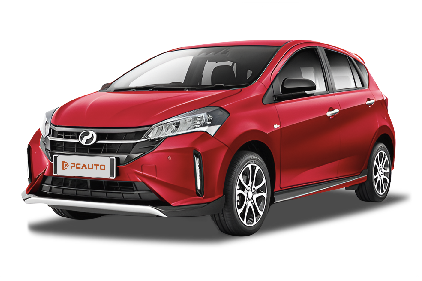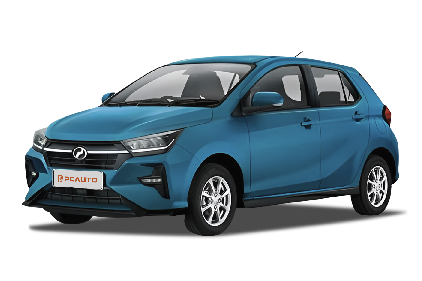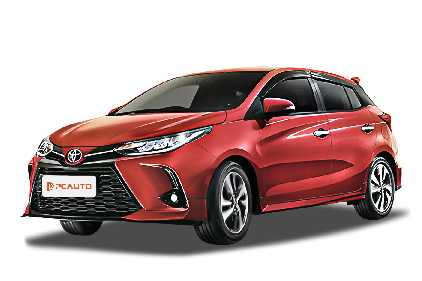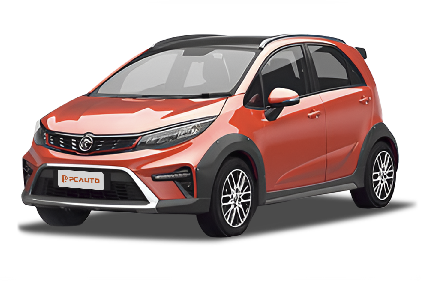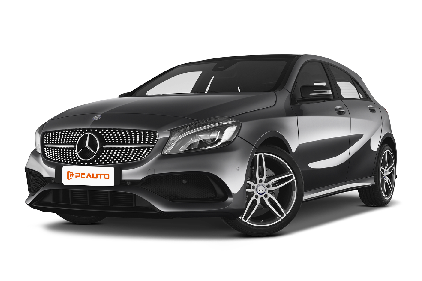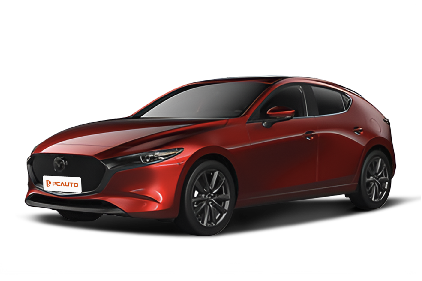Q
How much Malaysian Ringgit does it take to fill up a tank of petrol for the Perodua Myvi 1.5?
The Perodua Myvi 1.5 comes with a 36-liter fuel tank. Based on Malaysia's latest fuel prices, if you're filling up with RON 95 (priced at RM2.05 per liter), a full tank will set you back around RM73.80. Of course, the actual cost might vary slightly depending on fuel price fluctuations or how much fuel is left in the tank when you refuel.
What's worth noting is that the Myvi 1.5 delivers decent fuel efficiency. Official figures claim a combined fuel consumption of approximately 5.6 liters per 100 kilometers. Doing the math, that translates to a theoretical range of around 643 kilometers on a full tank. But let's be real—your actual mileage will depend on things like your driving style, the roads you take, and how much weight you're carrying.
For folks who do a lot of city commuting, the Myvi 1.5's running costs are pretty easy on the wallet. And to get even better fuel economy (which means saving more money in the long run), keeping up with regular maintenance and making sure your tires are properly inflated goes a long way.
Q
What is the price of Perodua Myvi?
The Perodua Myvi, one of Malaysia's most beloved national cars, comes with a range of prices depending on the trim and specs you go for. For the 2023 model year, you're looking at roughly 46,000 to 62,000 ringgit. The exact figure hinges on which variant ticks your boxes: there's the 1.3L X, 1.3L H, 1.5L H, and the top-dog 1.5L AV. That range-topping 1.5L AV packs in some nice upgrades, like advanced driver assistance systems (ADAS) and LED headlights.
What makes the Myvi a hit? It's all about being easy on the wallet, sipping fuel gently, and just plain reliable—total no-brainer for city commutes or family runs. And let's not forget its nimble size, which makes navigating Malaysia's tighter roads a breeze. On top of that, it holds its value pretty well on the used market, adding to its long-term appeal for folks watching their pennies.
If your budget isn't exactly overflowing, the Myvi should definitely be on your shortlist. It nails the daily driving basics, and it doesn't skimp too much on safety or comfort either. Yep, that classic Perodua practicality shining through once again.
Q
What is the swept volume of Perodua Myvi ?
The displacement of the Perodua Myvi depends on the specific model and engine configuration. The latest Myvi models currently come with two main DVVT twin-cam engines: a 1.3-liter (1,329cc) and a 1.5-liter (1,496cc) unit. The 1.3-liter version features a 4-cylinder, 12-valve setup, while the 1.5-liter bumps it up to 16 valves. Both these displacements fall right in the sweet spot for small cars in the Malaysian market – they’re efficient enough for daily commuting while still packing enough punch for most driving needs.
Displacement is a key engine spec, directly impacting both power output and fuel economy. Perodua’s done a solid job here with lightweight engine design and variable valve timing tech. It keeps the engine compact but really optimizes combustion efficiency, which is a big reason the Myvi’s so popular for city driving around Malaysia.
If you’re an owner wanting the full tech specs, your best bet is to check the official Perodua manual or swing by an authorized service center. That way, you’ll get the most up-to-date and accurate info on your ride.
Q
How to balance the speaker in Perodua Myvi?
To get the best sound balance from your Perodua Myvi's speakers, start by diving into the car's audio settings menu. Tweak the Fader to adjust front-to-rear speaker levels and the Balance for left-right distribution, making sure the sound feels evenly spread throughout the cabin. If the stock speakers leave you wanting more, upgrading them or adding an amplifier can seriously boost sound quality—just stick to Myvi-compatible models to avoid electrical headaches.
Another pro tip: beefing up your door insulation cuts down on outside noise, letting your music shine clearer. For those really chasing premium sound, hit up a specialist car audio shop. They’ll fine-tune things based on your Myvi’s interior acoustics and your gear’s specs. Since the Myvi’s such a popular ride in Malaysia, the aftermarket scene is solid—plenty of parts to choose from. Just double-check modifications won’t void your factory warranty first.
At the end of the day, balancing speakers isn’t just technical—it’s personal. Play around with settings until it sounds *right* to you.
Q
How to connect the bluetooth to Perodua Myvi?
To connect to the Bluetooth feature in your Perodua Myvi, first make sure the vehicle is powered on and the infotainment screen is active. Next, navigate through the head unit menu to find the "Bluetooth Settings" option and switch it on. At the same time, open your phone's Bluetooth settings and scan for available devices. Look for "Myvi" or a similar name in the list and select it to pair. Some models might require entering a default PIN like "0000" or "1234" to complete the connection. Once successfully linked, the infotainment screen will usually display your phone's name or a Bluetooth icon, letting you stream music or take calls through the car's system. It's worth noting that Myvi models from different years might have slightly different interfaces or Bluetooth capabilities – older versions, for example, might only support hands-free calling without audio streaming. For precise instructions, it's best to check your vehicle's owner's manual. If you run into connection problems, try restarting both the car's infotainment system and your phone's Bluetooth, and ensure your phone's operating system is up to date for better compatibility. Bluetooth has become a standard feature in modern cars, and beyond wireless audio, some higher-end models now offer extras like Bluetooth keyless entry and remote control functions. These features really boost convenience, and as technology advances, we can expect car Bluetooth systems to integrate even more smart connectivity services in the future.
Q
What is the tensile stress on the single tire of Perodua Myvi car?
When it comes to the tensile stress of a single tire on the Perodua Myvi, you'll need to check the original technical manual or the tire manufacturer's specifications for exact numbers. That's because tire models can vary across different model years. Take common sizes like 165/55 R15 or 185/55 R15, for example – the design of their carcass ply layers affects how they handle tensile stress. Typically, passenger car tires have ply layers with tensile stress ranging from 100 to 300 MPa to ensure they can handle the load and last.
But here's the thing: tire stress isn't just about size. It also depends on inflation pressure, how much weight you're carrying, and driving conditions. Like, if you drive with low pressure for a long time, the sidewalls can end up with bent stress concentrations. And overloading? That'll seriously crank up the shear stress where the tire meets the road.
For Myvi owners, I'd recommend regularly checking your tire pressure – the factory suggests around 210 kPa – and avoiding overloading. That way, your tires stay in the best shape. If you need precise data, look at the "MAX LOAD" and "MAX PRESS" markings on the tire sidewalls, or swing by a Perodua authorized service center to get tech info specific to your ride.
Q
How to change the air-conditioner filter of Perodua Myvi ?
Swapping out the aircon filter in your Perodua Myvi is actually a piece of cake. First things first, you'll need a new filter – grab one that's specifically for your Myvi model, either from a Perodua dealership parts counter or any auto parts shop.
Next, head over to the glove box on the passenger side. Clear out whatever's inside, then take a look at the sides – you'll notice the clips holding it in place. Just give those clips a gentle press and pull outward, and the glove box should swing down fully. Now you'll see a rectangular cover – that's where the aircon filter lives. Press the clip on one side of this cover, pop it off, and there's your old filter.
Carefully pull out the old filter, making sure you note which way it was facing (direction matters!). Slide the new filter in the same orientation, double-checking that the edges fit snugly all around. Then just reverse the steps: put the cover back on, snap the glove box back into its clips, and you're done.
Pro tip: Aim to change this filter every 10,000 km or once a year, whichever comes first. Especially here in Malaysia's hot, humid weather – keeping up with this simple maintenance helps keep the air inside fresh, stops mold and dust from building up, and even helps your aircon cool more efficiently. If you're often driving through dusty areas, you might want to do it more frequently. Oh, and when you're buying a new filter, consider one with activated charcoal – it does a better job trapping odors and harmful gases, so your cabin air stays that much cleaner.
Q
how to change perodua myvi aircon filter
Swapping out the aircon filter in your Perodua Myvi is actually a straightforward DIY job you can handle yourself. First off, you'll need a new cabin air filter – make sure it's the right fit for your Myvi. You can usually grab one at auto parts stores or straight from a Perodua dealership. Pop open the glove box on the passenger side, clear out any stuff inside, and you'll notice the clips on both sides. Gently press those clips and pull the glove box down so it hangs open fully. That'll reveal the cover for the aircon filter. Just press the clip on one side of the cover to pop it off, then you can take out the old filter. Keep an eye on the arrow on the filter – that shows the direction air flows through it. When you put the new one in, make sure that arrow points the same way. Finally, just reverse the steps to put the cover and glove box back in place.
Changing your cabin air filter regularly – I recommend every 10,000 to 15,000 kilometers or once a year – really helps boost the air quality inside your car. It cuts down on dust and weird smells, plus it protects your AC system from getting clogged up, which can make it less effective at cooling. And if you do a lot of driving in dusty areas, you might want to change it even more often to keep that AC running at its best. If you're not totally sure about doing it yourself, check your owner's manual or swing by a Perodua authorized service center for some pro help.
Q
how to connect bluetooth to perodua myvi
To pair your phone's Bluetooth with a Perodua Myvi, start by making sure the car is in ignition or running. Then power up the infotainment system on the center console, head into the settings menu, select "Bluetooth," and put it into pairing mode. Over on your phone, switch on Bluetooth too, scan for available devices, and look for "Myvi" or a similar name in the list—tap that to connect. Some models might ask for a default PIN like "0000" or "1234" to finish pairing. Once it's locked in, the infotainment screen should show a confirmation message, and you're good to stream music or take calls wirelessly.
Heads up though—Myvi's media systems can vary a bit across model years, so if you hit snags, check the owner's manual or try restarting both devices. Bluetooth is pretty much a standard feature in modern cars these days, and it does more than just play music—you can usually mirror your phone screen or use voice commands too. It’s a good idea to keep both your phone and the car’s system updated to work with the latest tech, and try not to connect too many devices at once to avoid signal issues. If you start getting delays or random disconnects after using it for a while, it might be worth checking the Bluetooth module or antenna, or taking it to a Perodua service center to have it looked at.
Q
how yo balance speaker in perodua myvi
To balance the speaker sound in your Perodua Myvi, start by tweaking the EQ settings in the infotainment system. Dive into the audio menu and adjust the treble, mid, and bass levels to your taste—crank up the mids for clearer vocals or boost the bass if you’re into that thump. Don’t sleep on the fader control either; use it to balance the front and rear speakers so the sound isn’t all bunched up in one spot.
If you’re craving better sound quality, upgrading the stock speakers or adding some sound deadening material can make a big difference, cutting down on road noise. Just make sure any mods follow the factory specs to keep your warranty intact. The Myvi’s stock system handles daily drives just fine, but for audiophiles, hitting up a pro car audio shop for custom tuning or upgrades is worth considering. And since Malaysia’s weather is hot and humid, pick gear that can handle the heat and moisture to keep it working smoothly for the long haul.

.jpg)

.jpg)


